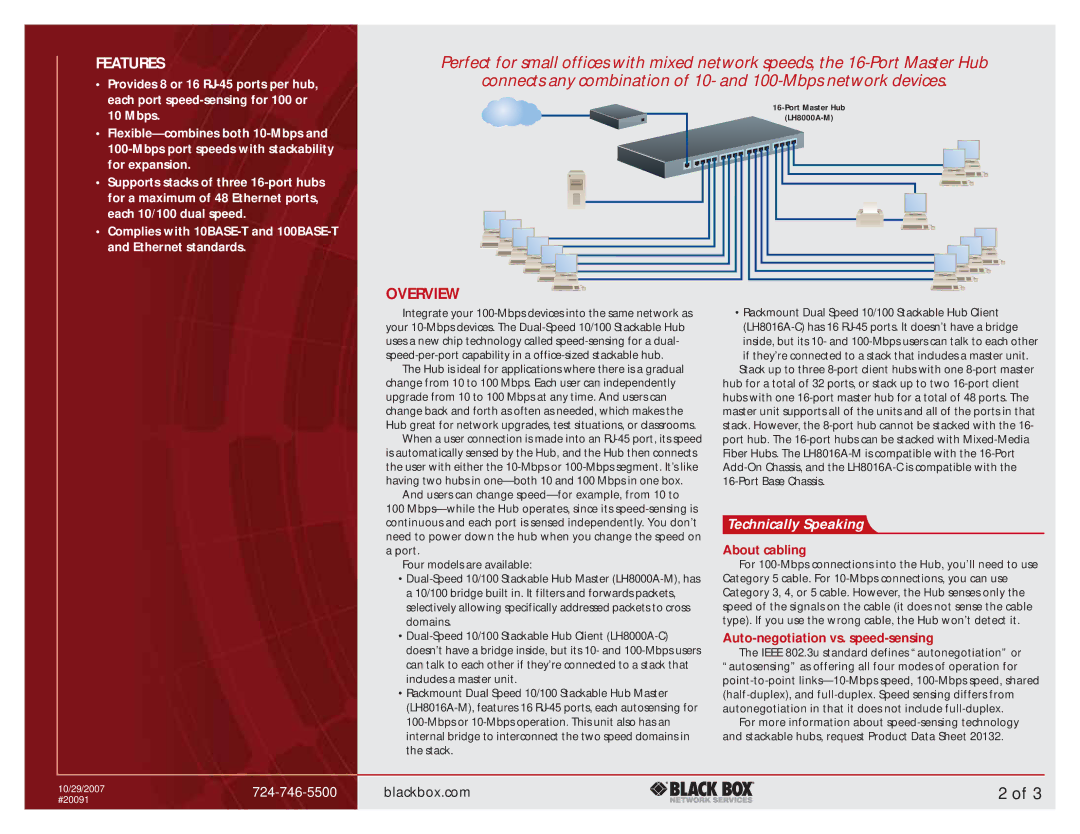OVERVIEW
Integrate your 100-Mbps devices into the same network as your 10-Mbps devices. The Dual-Speed 10/100 Stackable Hub uses a new chip technology called speed-sensing for a dual- speed-per-port capability in a office-sized stackable hub.
The Hub is ideal for applications where there is a gradual change from 10 to 100 Mbps. Each user can independently upgrade from 10 to 100 Mbps at any time. And users can change back and forth as often as needed, which makes the Hub great for network upgrades, test situations, or classrooms.
When a user connection is made into an RJ-45 port, its speed is automatically sensed by the Hub, and the Hub then connects the user with either the 10-Mbps or 100-Mbps segment. It’s like having two hubs in one—both 10 and 100 Mbps in one box.
And users can change speed—for example, from 10 to 100 Mbps—while the Hub operates, since its speed-sensing is continuous and each port is sensed independently. You don’t need to power down the hub when you change the speed on a port.
Four models are available:
•Dual-Speed 10/100 Stackable Hub Master (LH8000A-M), has a 10/100 bridge built in. It filters and forwards packets, selectively allowing specifically addressed packets to cross domains.
•Dual-Speed 10/100 Stackable Hub Client (LH8000A-C) doesn’t have a bridge inside, but its 10- and 100-Mbps users can talk to each other if they’re connected to a stack that includes a master unit.
•Rackmount Dual Speed 10/100 Stackable Hub Master (LH8016A-M), features 16 RJ-45 ports, each autosensing for 100-Mbps or 10-Mbps operation. This unit also has an internal bridge to interconnect the two speed domains in the stack.
16-Port Master Hub
(LH8000A-M)
•Rackmount Dual Speed 10/100 Stackable Hub Client (LH8016A-C) has 16 RJ-45 ports. It doesn’t have a bridge inside, but its 10- and 100-Mbps users can talk to each other
if they’re connected to a stack that includes a master unit. Stack up to three 8-port client hubs with one 8-port master
hub for a total of 32 ports, or stack up to two 16-port client hubs with one 16-port master hub for a total of 48 ports. The master unit supports all of the units and all of the ports in that stack. However, the 8-port hub cannot be stacked with the 16- port hub. The 16-port hubs can be stacked with Mixed-Media Fiber Hubs. The LH8016A-M is compatible with the 16-Port Add-On Chassis, and the LH8016A-C is compatible with the 16-Port Base Chassis.
Technically Speaking
About cabling
For 100-Mbps connections into the Hub, you’ll need to use Category 5 cable. For 10-Mbps connections, you can use Category 3, 4, or 5 cable. However, the Hub senses only the speed of the signals on the cable (it does not sense the cable type). If you use the wrong cable, the Hub won’t detect it.
Auto-negotiation vs. speed-sensing
The IEEE 802.3u standard defines “autonegotiation” or “autosensing” as offering all four modes of operation for point-to-point links—10-Mbps speed, 100-Mbps speed, shared (half-duplex), and full-duplex. Speed sensing differs from autonegotiation in that it does not include full-duplex.
For more information about speed-sensing technology and stackable hubs, request Product Data Sheet 20132.

